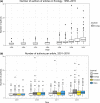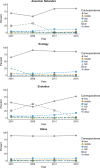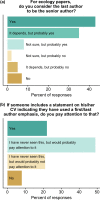Last and corresponding authorship practices in ecology
- PMID: 29152184
- PMCID: PMC5677469
- DOI: 10.1002/ece3.3435
Last and corresponding authorship practices in ecology
Abstract
Authorship is intended to convey information regarding credit and responsibility for manuscripts. However, while there is general agreement within ecology that the first author is the person who contributed the most to a particular project, there is less agreement regarding whether being last author is a position of significance and regarding what is indicated by someone being the corresponding author on a manuscript. Using an analysis of papers published in American Naturalist, Ecology, Evolution, and Oikos, I found that: (1) the number of authors on papers is increasing over time; (2) the proportion of first authors as corresponding author has increased over time, as has the proportion of last authors as corresponding author; (3) 84% of papers published in 2016 had the first author as corresponding author; and (4) geographic regions differed in the likelihood of having the first (or last) author as corresponding author. I also carried out an online survey to better understand views on last and corresponding authorship. This survey revealed that most ecologists view the last author as the "senior" author on a paper (i.e., the person who runs the research group in which most of the work was carried out), and most ecologists view the corresponding author as the person taking full responsibility for a paper. However, there was substantial variation in views on authorship, especially corresponding authorship. Given these results, I suggest that discussions of authorship have as their starting point that the first author will be corresponding author and the senior author will be last author. I also suggest ways of deciding author order in cases where two senior authors contributed equally.
Keywords: authorship; contribution statements; corresponding author; last author.
Figures








Similar articles
-
Patterns of authorship in ecology and evolution: First, last, and corresponding authorship vary with gender and geography.Ecol Evol. 2018 Nov 8;8(23):11492-11507. doi: 10.1002/ece3.4584. eCollection 2018 Dec. Ecol Evol. 2018. PMID: 30598751 Free PMC article.
-
Coauthors' contributions to major papers published in the AJR: frequency of undeserved coauthorship.AJR Am J Roentgenol. 1996 Sep;167(3):571-9. doi: 10.2214/ajr.167.3.8751654. AJR Am J Roentgenol. 1996. PMID: 8751654
-
'Author Contribution Details' and not 'Authorship Sequence' as a merit to determine credit: A need to relook at the current Indian practice.Natl Med J India. 2020 Jan-Feb;33(1):24-30. doi: 10.4103/0970-258X.308238. Natl Med J India. 2020. PMID: 33565483 Review.
-
Author contributions to ecological publications: What does it mean to be an author in modern ecological research?PLoS One. 2017 Jun 26;12(6):e0179956. doi: 10.1371/journal.pone.0179956. eCollection 2017. PLoS One. 2017. PMID: 28650967 Free PMC article.
-
Authorship in Scientific Manuscripts.Indian J Orthop. 2023 May 2;57(6):783-788. doi: 10.1007/s43465-023-00896-5. eCollection 2023 Jun. Indian J Orthop. 2023. PMID: 37214360 Free PMC article. Review.
Cited by
-
Resolving authorship disputes by mediation and arbitration.Res Integr Peer Rev. 2018 Nov 16;3:12. doi: 10.1186/s41073-018-0057-z. eCollection 2018. Res Integr Peer Rev. 2018. PMID: 30473872 Free PMC article.
-
Patterns of authorship in ecology and evolution: First, last, and corresponding authorship vary with gender and geography.Ecol Evol. 2018 Nov 8;8(23):11492-11507. doi: 10.1002/ece3.4584. eCollection 2018 Dec. Ecol Evol. 2018. PMID: 30598751 Free PMC article.
-
Male principal investigators (almost) don't publish with women in ecology and zoology.PLoS One. 2019 Jun 19;14(6):e0218598. doi: 10.1371/journal.pone.0218598. eCollection 2019. PLoS One. 2019. PMID: 31216351 Free PMC article.
-
Towards women-inclusive ecology: Representation, behavior, and perception of women at an international conference.PLoS One. 2021 Dec 10;16(12):e0260163. doi: 10.1371/journal.pone.0260163. eCollection 2021. PLoS One. 2021. PMID: 34890389 Free PMC article.
-
Gender differences in animal cognition science.Anim Cogn. 2023 Jul;26(4):1295-1305. doi: 10.1007/s10071-023-01777-y. Epub 2023 Apr 18. Anim Cogn. 2023. PMID: 37071241
References
-
- Bhandari, M. , Guyatt, G. H. , Kulkarni, A. V. , Devereaux, P. J. , Leece, P. , Bajammal, S. , … Busse, J. W. (2014). Perceptions of authors’ contributions are influenced by both byline order and designation of corresponding author. Journal of Clinical Epidemiology, 67, 1049–1054. - PubMed
-
- Bryer, J. , & Speerschneider, K. (2016). likert: Analysis and visualization likert items. https://CRAN.R-project.org/package=likert
-
- Davis, P. J. , & Gregerman, R. I. (1969). Parse analysis: A new method for the evaluation of investigators’ bibliographies. New England Journal of Medicine, 281, 989–990. - PubMed
LinkOut - more resources
Full Text Sources
Other Literature Sources
Molecular Biology Databases

